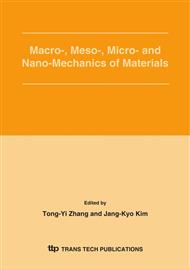p.9
p.15
p.21
p.31
p.41
p.51
p.59
p.69
p.79
Cyclic Stress-Strain Behavior and Thermomechanical Effect in Metal Matrix Composites
Abstract:
A micromechanical model based on continuum analysis has been investigated by using finite element analysis (FEA) in discontinuous metal matrix composites (DMMC). To assess the tensile and compressive constitutive responses, a cyclic stress-strain behavior has been performed. For analysis procedure, the elastoplastic FEA and the regularly aligned axisymmetric single fiber model have been implemented to evaluate the internal field quantities. Accordingly, the fiber and matrix internal stresses were investigated for the constrained representative volume element (RVE). Further, the local plasticity in the matrix were described during loading and unloading precesses, which can predict the damage mechanisms as well as strengthening mechanisms. On the other hand, a thermoelasto- plastic analysis has been performed using FEA for the application to the continuum behavior in a discontinuous metal matrix composite. The internal field quantities of composite as well as overall composite behavior and an experiment was demonstrated to compare with the numerical simulation. As the procedure, the reasonably optimized FE mesh generations, the appropriate imposition of boundary conditions, and the relevant postprocessing such as elasto-plastic thermo-mechanical analysis were taken into account. For micromechanical model, the temperature dependent material properties and precipitation hardening effects have been employed to investigate field quantities. It was found that the residual stresses are induced substantially by the temperature drop during heat treatment and that the FEA results give a good agreement with experimental data.
Info:
Periodical:
Pages:
41-50
Citation:
Online since:
September 2005
Authors:
Price:
Сopyright:
© 2005 Trans Tech Publications Ltd. All Rights Reserved
Share:
Citation:


